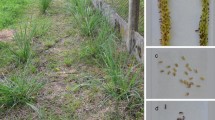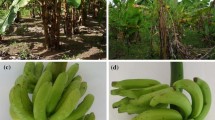Summary
Colchicine induced autotetraploid progenies belonging to two different years were compared with their diploid progenitor for various characters. Most of the characters of the autotetraploid exhibit a decrease over that of the diploid except in the case of petal size and pod breadth which have increased slightly. The unfavourable effect is rather drastic particularly in respect of characters affecting the yield of the plant.
Since very similar results have been obtained inrahar (Cajanus indicus Spreng), it is suggested that colchicine induced autotetraploidy may not prove to be a suitable method for improving the various pulse crops.
Similar content being viewed by others
o|
1. “Induction of Polyploidy in Crop Plant,” L. S. S. Kumar and A. Abraham,Current Science, 1942,2, No. 3, pp. 112–14.
“Study of Colchicine Induced Polyploidy inPhaseolus radiatus L.,” L. S. S. Kumar and A. Abraham,Jour. University of Bombay, 1942,11, Pt. 3, 30–36.
A Preliminary Note on AutotetraploidCajanus indicus, by L. S. S. Kumar, A. Abraham and V. K. Srinivasan,Proc. Ind. Acad. Sci. (In Press).
Author information
Authors and Affiliations
Additional information
The paper was read before the Joint Meeting of the Indian Academy of Sciences, Bangalore, and the National Academy of Sciences, United Provinces, held at Poona in December 1944.
Rights and permissions
About this article
Cite this article
Kumar, L.S.S. A comparative study of autotetroploid and diploid types inmung (Phaseolus radiatus Linn . Proc. Indian Acad. Sci. 21, 266–268 (1945). https://doi.org/10.1007/BF03049873
Received:
Issue Date:
DOI: https://doi.org/10.1007/BF03049873




